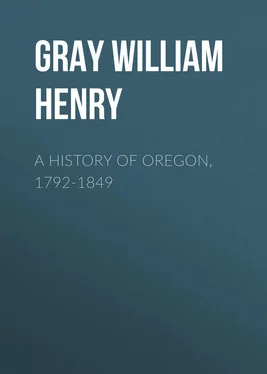William Gray - A History of Oregon, 1792-1849
Здесь есть возможность читать онлайн «William Gray - A History of Oregon, 1792-1849» — ознакомительный отрывок электронной книги совершенно бесплатно, а после прочтения отрывка купить полную версию. В некоторых случаях можно слушать аудио, скачать через торрент в формате fb2 и присутствует краткое содержание. Жанр: literature_19, foreign_antique, foreign_prose, Историческая проза, на английском языке. Описание произведения, (предисловие) а так же отзывы посетителей доступны на портале библиотеки ЛибКат.
- Название:A History of Oregon, 1792-1849
- Автор:
- Жанр:
- Год:неизвестен
- ISBN:нет данных
- Рейтинг книги:5 / 5. Голосов: 1
-
Избранное:Добавить в избранное
- Отзывы:
-
Ваша оценка:
- 100
- 1
- 2
- 3
- 4
- 5
A History of Oregon, 1792-1849: краткое содержание, описание и аннотация
Предлагаем к чтению аннотацию, описание, краткое содержание или предисловие (зависит от того, что написал сам автор книги «A History of Oregon, 1792-1849»). Если вы не нашли необходимую информацию о книге — напишите в комментариях, мы постараемся отыскать её.
A History of Oregon, 1792-1849 — читать онлайн ознакомительный отрывок
Ниже представлен текст книги, разбитый по страницам. Система сохранения места последней прочитанной страницы, позволяет с удобством читать онлайн бесплатно книгу «A History of Oregon, 1792-1849», без необходимости каждый раз заново искать на чём Вы остановились. Поставьте закладку, и сможете в любой момент перейти на страницу, на которой закончили чтение.
Интервал:
Закладка:
Mr. Townsend had gathered from the gentlemen of the Hudson’s Bay Company, during the year he had been in the country, a good knowledge of their policy, and of their manner of treatment and trade with the Indians. He had also learned from conversations with Rev. Samuel Parker and the various members of the company, their views and feelings, not only toward American traders, but of the missionary occupation of the country by the Americans. The mission party of 1836 learned from Mr. McLeod that the Hudson’s Bay Company had sent for a chaplain, to be located at Vancouver, and from Mr. Townsend that he had arrived.
It will be borne in mind that this honorable company, on the arrival of Rev. J. Lee and party to look after the civil and religious welfare of the Indians, examined their old charter, and found that one of its requirements was to Christianize as well as trade with the natives of this vast country. They found that the English church service must be read at their posts on the Sabbath. To conform to this regulation, a chaplain was sent for. He came, with his wife; and not receiving the submission and attention from the chivalry of the country he demanded, became thoroughly disgusted, and returned to England (I think) on the same ship he came in. As we proceed, we will develop whys and wherefores.
Old Fort Wallawalla, in 1836, when the mission party arrived, was a tolerably substantial stockade, built of drift-wood taken from the Columbia River, of an oblong form, with two log bastions raised, one on the southwest corner, commanding the river-front and southern space beyond the stockade; the other bastion was on the northeast corner, commanding the north end, and east side of the fort. In each of these bastions were kept two small cannon, with a good supply of small-arms. These bastions were always well guarded when any danger was suspected from the Indians. The sage brush, willow, and grease-wood had been cut and cleared away for a considerable distance around, to prevent any Indians getting near the fort without being discovered. Inside the stockade were the houses, store, and quarters for the men, with a space sufficiently large to corral about one hundred horses. The houses and quarters were built by laying down sills, placing posts at from eight to twelve feet apart, with tenons on the top, and the bottom grooved in the sides, and for corner-posts, so as to slip each piece of timber, having also a tenon upon each end, into the grooves of the posts, forming a solid wall of from four to six inches thick, usually about seven feet high from floor to ceiling, or timbers overhead. The roofs were of split cedar, flattened and placed upon the ridge pole and plate-like rafters, close together; then grass or straw was put on the split pieces, covered with mud and dirt, and packed to keep the straw from blowing off. The roofs were less than one-fourth pitch, and of course subject to leakage when it rained. For floors, split puncheons or planks were used in the chief trader’s quarters. In the corner of the room was a comfortable fireplace, made of mud in place of brick. The room was lighted with six panes of glass, seven inches by nine, set in strips of wood, split with a common knife, and shaped so as to hold the glass in place of a sash.
The doors were also of split lumber, rough hewn, wrought-iron hinges, and wooden latches; the furniture consisted of three benches, two stools, and one chair (something like a barber’s chair, without the scrolls and cushions); a bed in one corner of the room upon some split boards for bottom; a rough table of the same material roughly planed. This, with a few old cutlasses, shot-pouches, and tobacco sacks (such as were manufactured by the Indians about the post), constituted the room and furniture occupied by P. C. Pambrun, Esq., of the Honorable Hudson’s Bay Company. Into this room the mission party were invited, and introduced to Mrs. Pambrun and two young children-misses. The kind and cordial reception of Mr. Pambrun was such that all felt cheerful and relieved in this rude specimen of half-native, half-French dwelling. The cloth was soon spread upon the table, and the cook brought in the choice game of the prairies well cooked, with a small supply of Irish potatoes and small Canadian yellow corn. This was a feast, as well as a great change from dried and pounded buffalo meat “straight,” as the miners say, upon which we had subsisted since we left the rendezvous, except the occasional fresh bits we could get along the route. Dinner being disposed of, some fine melons were served, which Mr. Pambrun had succeeded in raising in his little melon patch, in the bends of the Wallawalla River, about two miles from the fort. The supply of melons was quite limited, a single one of each kind for the party. Mr. Townsend on this occasion yielded his share to the ladies, and insisted, as he had been at the fort and partaken of them on previous occasions, they should have his share. Dinner over, melons disposed of, fort, stores, and quarters examined, arrangements were made for sleeping in the various sheds and bastions of the fort. Most of the gentlemen preferred the open air and tent to the accommodations of the fort. Rooms were provided for the two ladies and their husbands, Dr. Whitman and Mr. Spalding.
Next morning early, Messrs. McLeod and Townsend started for Vancouver in a light boat, with the understanding that Mr. Pambrun, with the company’s furs, and the mission party, were to follow in a few days. Mr. McKay was to remain in charge of the fort. All things were arranged to Mr. Pambrun’s satisfaction; two boats or barges were made ready, the furs and party all aboard, with seven men to each barge, six to row and one to steer, with a big paddle instead of a helm, or an oar; we glided swiftly down the Columbia River, the scenery of which is not surpassed in grandeur by any river in the world. Fire, earth, and water have combined to make one grand display with melted lava, turning it out in all imaginable and unimaginable shapes and forms on a most gigantic scale. In other countries, these hills thrown up would be called mountains, but here we call them high rolling plains, interspersed with a few snow-capped peaks, some fifteen and some seventeen thousand feet high. The river is running through these plains, wandering around among the rocks with its gentle current of from four to eight knots per hour; at the rapids increasing its velocity and gyrations around and among the rocks in a manner interesting and exciting to the traveler, who at one moment finds his boat head on at full speed making for a big rock; anon he comes along, and by an extra exertion with his pole shoves off his boat to receive a full supply of water from the rolling swell, as the water rushes over the rock he has but just escaped being dashed to pieces against. As to danger in such places, it is all folly to think of any; so on we go to repeat the same performance over and over till we reach the falls, at what is now called Celilo, where we find about twenty-five feet perpendicular fall.
Our boats were discharged of all their contents, about one-fourth of a mile above the main fall, on the right bank of the river. Then the cargo was packed upon the Indians’ backs to the landing below the falls, the Indian performing this part of the labor for from two to six inches of trail-rope tobacco. A few were paid from two to ten charges of powder and ball, or shot, depending upon the number of trips they made and the amount they carried. The boats were let down with lines as near the fall as was considered safe, hauled out of the water, turned bottom up, and as many Indians as could get under them, say some twenty-five to each boat, lifted them upon their shoulders and carried them to the water below. For this service they each received two dried leaves of tobacco, which would make about six common pipefuls. The Indian, however, with other dried leaves, would make his two leaves of tobacco last some time.
Читать дальшеИнтервал:
Закладка:
Похожие книги на «A History of Oregon, 1792-1849»
Представляем Вашему вниманию похожие книги на «A History of Oregon, 1792-1849» списком для выбора. Мы отобрали схожую по названию и смыслу литературу в надежде предоставить читателям больше вариантов отыскать новые, интересные, ещё непрочитанные произведения.
Обсуждение, отзывы о книге «A History of Oregon, 1792-1849» и просто собственные мнения читателей. Оставьте ваши комментарии, напишите, что Вы думаете о произведении, его смысле или главных героях. Укажите что конкретно понравилось, а что нет, и почему Вы так считаете.












